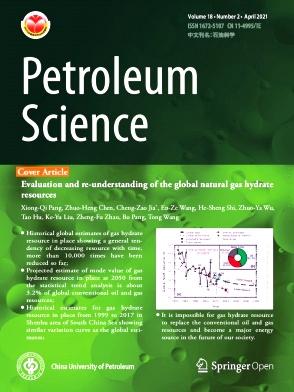准噶尔盆地马湖凹陷二叠系丰城组碱性湖相页岩微观油赋存特征
IF 6
1区 工程技术
Q2 ENERGY & FUELS
引用次数: 0
摘要
碱性湖相页岩非均质性强,有机-无机孔隙网络与油气赋存关系复杂,制约了页岩油勘探开发的有效性。以马湖凹陷凤城组(P1f)为研究对象。综合地球化学、索氏萃取、扫描电镜、气体吸附、核磁共振T1-T2波谱等技术手段,研究页岩微观油赋存机制。结果表明,P1f中存在长英质页岩、白云质页岩、灰质页岩和混合页岩。基质孔隙和与无机矿物相关的微裂缝是P1f的主要孔隙类型。吸附油主要分布在有机质和粘土矿物表面,而游离油主要分布在孔径较大的无机孔隙和微裂缝中。页岩油成藏数量和分布在不同尺度上存在差异,游离油和吸附油分别受直径大于10 nm的优势孔和直径小于10 nm的无效孔控制。页岩油赋存特征受有机质、孔隙结构和矿物组成的影响。长英质页岩优势孔隙丰度高,含油量最高,优势孔隙中以游离油为主,具有良好的流动性。白云岩页岩和灰岩页岩流体赋存状态复杂,含油量低,游离油与吸附油之比为1:1。混合页岩黏土矿物含量升高,优势孔隙稀缺。此外,无效孔隙含有更多的束缚水,导致含油量中等,主要是由于吸附作用而限制了流动性。目前,页岩油主要以游离态赋存于直径大于10 nm的优势孔隙中。在碱性湖相页岩油资源勘探开发中,应重点识别以优势孔隙为特征的长英质页岩中的甜点。本文章由计算机程序翻译,如有差异,请以英文原文为准。
Microscopic oil occurrence in the Permian alkaline lacustrine shales: Fengcheng formation, Mahu Sag, Junggar basin
Alkaline lacustrine shale is highly heterogeneous, and the complex relationship between the organic-inorganic porosity network and hydrocarbon occurrence restricts the effectiveness of shale oil exploration and development. Herein, we investigated the Fengcheng Formation (P1f) in Mahu Sag. This study integrated geochemistry, Soxhlet extraction, scanning electron microscopy, gas adsorption, and nuclear magnetic resonance T1-T2 spectroscopy to elucidate the microscopic oil occurrence mechanisms in shales. Results indicate the presence of felsic shale, dolomitic shale, lime shale, and mixed shale within the P1f. Matrix pores and microfractures associated with inorganic minerals are the predominant pore types in P1f. Adsorbed oil primarily resides on the surfaces of organic matter and clay minerals, while free oil predominantly occupies inorganic pores and microfractures with larger pore sizes. Variations exist in the quantity and distribution of shale oil accumulation across different scales, where free oil and adsorbed oil are governed by dominant pores with diameters exceeding 10 nm and ineffective pores with diameters below 10 nm, respectively. Shale oil occurrence characteristics are influenced by organic matter, pore structure, and mineral composition. Felsic shale exhibits a high abundance of dominant pores, possesses the highest oil content, predominantly harbors free oil within these dominant pores, and demonstrates good mobility. Fluid occurrence in dolomitic shale and lime shale is intricate, with low oil content and a free oil to adsorbed oil ratio of 1:1. Mixed shale exhibits elevated clay mineral content and a scarcity of dominant pores. Moreover, ineffective pores contain increased bound water, resulting in medium oil content and limited mobility predominantly due to adsorption. Presently, shale oil mainly occurs in the dominant pores with a diameter larger than 10 nm in a free state. During the exploration and development of alkaline lacustrine shale oil resources, emphasis should be placed on identifying sweet spots within the felsic shale characterized by dominant pores.
求助全文
通过发布文献求助,成功后即可免费获取论文全文。
去求助
来源期刊

Petroleum Science
地学-地球化学与地球物理
CiteScore
7.70
自引率
16.10%
发文量
311
审稿时长
63 days
期刊介绍:
Petroleum Science is the only English journal in China on petroleum science and technology that is intended for professionals engaged in petroleum science research and technical applications all over the world, as well as the managerial personnel of oil companies. It covers petroleum geology, petroleum geophysics, petroleum engineering, petrochemistry & chemical engineering, petroleum mechanics, and economic management. It aims to introduce the latest results in oil industry research in China, promote cooperation in petroleum science research between China and the rest of the world, and build a bridge for scientific communication between China and the world.
 求助内容:
求助内容: 应助结果提醒方式:
应助结果提醒方式:


